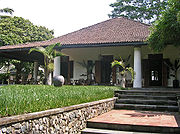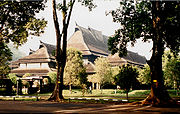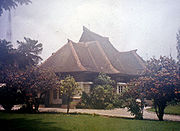
Colonial architecture of Indonesia
Encyclopedia

Dutch East Indies
The Dutch East Indies was a Dutch colony that became modern Indonesia following World War II. It was formed from the nationalised colonies of the Dutch East India Company, which came under the administration of the Netherlands government in 1800....
era were built across the archipelago.
Early architecture: replicating the mother country
The 16th and 17th centuries saw the arrival of European powers in Indonesia who used masonryMasonry
Masonry is the building of structures from individual units laid in and bound together by mortar; the term masonry can also refer to the units themselves. The common materials of masonry construction are brick, stone, marble, granite, travertine, limestone; concrete block, glass block, stucco, and...
for much of their construction. Previously timber and its by-products had been almost exclusively used in Indonesia, with the exception of some major religious and palace architecture. One of the first major Dutch
Netherlands
The Netherlands is a constituent country of the Kingdom of the Netherlands, located mainly in North-West Europe and with several islands in the Caribbean. Mainland Netherlands borders the North Sea to the north and west, Belgium to the south, and Germany to the east, and shares maritime borders...
settlements was Batavia (later Jakarta) which in the 17th and 18th centuries was a fortified brick and masonry city.
For almost two centuries, the colonialists did little to adapt their European architectural habits to the tropical climate. In Batavia, for example, they constructed canals through its low-lying terrain, which were fronted by small-windowed and poorly ventilated row houses, mostly in a Chinese-Dutch hybrid style. The canals became dumping grounds for noxious waste and sewage and an ideal breeding ground for the anopheles
Anopheles
Anopheles is a genus of mosquito. There are approximately 460 recognized species: while over 100 can transmit human malaria, only 30–40 commonly transmit parasites of the genus Plasmodium, which cause malaria in humans in endemic areas...
mosquitos, with malaria and dysentery
Dysentery
Dysentery is an inflammatory disorder of the intestine, especially of the colon, that results in severe diarrhea containing mucus and/or blood in the faeces with fever and abdominal pain. If left untreated, dysentery can be fatal.There are differences between dysentery and normal bloody diarrhoea...
becoming rife throughout the Dutch East Indies
Dutch East Indies
The Dutch East Indies was a Dutch colony that became modern Indonesia following World War II. It was formed from the nationalised colonies of the Dutch East India Company, which came under the administration of the Netherlands government in 1800....
colonial capital.
Adaptation to the local environment

Verandah
A veranda or verandah is a roofed opened gallery or porch. It is also described as an open pillared gallery, generally roofed, built around a central structure...
s, portico
Portico
A portico is a porch leading to the entrance of a building, or extended as a colonnade, with a roof structure over a walkway, supported by columns or enclosed by walls...
s, large windows and ventilation openings). The Indo-European hybrid villa
Indo-European house
The Indo-European house was a nineteenth century architectural style in the Dutch East Indies.They were among the first European colonial buildings in Indonesia to incorporate indigenous architectural elements and attempt adapting to the climate...
of the 19th century were among the first colonial buildings to incorporate Indonesian architectural elements and attempt adapting to the climate. The basic form, such as the longitudinal organisation of spaces and use of joglo and limasan roof structures, was Javanese, but it incorporated European decorative elements such as neo-classical
Neoclassicism
Neoclassicism is the name given to Western movements in the decorative and visual arts, literature, theatre, music, and architecture that draw inspiration from the "classical" art and culture of Ancient Greece or Ancient Rome...
columns around deep verandahs.
Whereas the Indo-European homes were essentially Indonesian houses with European trim, by the early 20th century, the trend was for modernist influences—such as art-deco—being expressed in essentially European buildings with Indonesian trim (such as the pictured home's high-pitched roofs with Javan ridge details). Practical measures carried over from the earlier Indo-European hybrids, which responded to the Indonesian climate, included overhanging eaves, larger windows and ventilation in the walls.
20th century modernisms

Jakarta
Jakarta is the capital and largest city of Indonesia. Officially known as the Special Capital Territory of Jakarta, it is located on the northwest coast of Java, has an area of , and a population of 9,580,000. Jakarta is the country's economic, cultural and political centre...
, Semarang
Semarang
- Economy :The western part of the city is home to many industrial parks and factories. The port of Semarang is located on the north coast and it is the main shipping port for the province of Central Java. Many small manufacturers are located in Semarang, producing goods such as textiles,...
, and Surabaya
Surabaya
Surabaya is Indonesia's second-largest city with a population of over 2.7 million , and the capital of the province of East Java...
. Bandung is of particular note with one of the largest remaining collections of 1920s Art-Deco buildings in the world, with the notable work of several Dutch architects and planners, including Albert Aalbers
Albert Aalbers
Albert Frederik Aalbers was a Dutch architect who created elegant villas, hotels and office buildings in Bandung, Indonesia under Dutch colonial rule in the 1930s...
, Thomas Karsten
Thomas Karsten
Herman Thomas Karsten was a Dutch engineer who gave major contributions to architecture and town planning in Indonesia during Dutch colonial rule. Most significantly he integrated the practice of colonial urban environment with native elements; a radical approach to spatial planning for Indonesia...
, Henri Maclaine Pont
Henri Maclaine Pont
Henri Maclaine Pont was a Dutch architect and archaeologist active in Indonesia, acclaimed for his synthesis of Javanese and western architecture.-Biography:...
, J Gerber and C.P.W. Schoemaker
Wolff Schoemaker
Charles Prosper Wolff Schoemaker was a Dutch architect who designed several distinguished Art Deco buildings in Bandung, Indonesia, including the Villa Isola and Hotel Preanger. He has been described as "the Frank Lloyd Wright of Indonesia," and Wright had a considerable influence on Schoemaker's...
.
In the first three decades of the twentieth century, the Public Works Department rolled out major public building and city planning programs. The key designer was Karsten who developed his predecessors' ideas for incorporating indigenous Indonesian elements into rational European forms. His first commission upon arrival in the Indies was the New Candi suburb of Semarang
Semarang
- Economy :The western part of the city is home to many industrial parks and factories. The port of Semarang is located on the north coast and it is the main shipping port for the province of Central Java. Many small manufacturers are located in Semarang, producing goods such as textiles,...
on the north coast of Central Java. He led the urban expansion and rebuilding of 12 of the 19 municipalities in Java and 3 out of 9 in Sumatra.
The outer islands
Colonial rule was never as extensive on the island of BaliBali
Bali is an Indonesian island located in the westernmost end of the Lesser Sunda Islands, lying between Java to the west and Lombok to the east...
as it was on Java— it was only in 1906, for example, that the Dutch gained full control of the island—and consequently the island only has a limited stock of colonial architecture. Singaraja
Singaraja
Singaraja is the regency seat of Buleleng, Bali, Indonesia. The name is Indonesian for "Lion King". It is on the north coast just east of Lovina...
, the island's former colonial capital and port, has a number of art-deco kantor style homes, tree-lined streets and dilapidated warehouses. The hill town of Munduk, a town amongst plantations established by the Dutch, is Bali's only other significant group of colonial architecture; a number of mini mansions in the Balinese-Dutch style still survive.
There are numerous forts built by European powers across the archipelago, but particularly in the Maluku Islands
Maluku Islands
The Maluku Islands are an archipelago that is part of Indonesia, and part of the larger Maritime Southeast Asia region. Tectonically they are located on the Halmahera Plate within the Molucca Sea Collision Zone...
, during the early colonial era to protect their share of the spice trade. Ambon City
Ambon City
Ambon is the main city and seaport of Ambon Island, and is the capital of Maluku province of Indonesia. It is one of the largest cities in eastern Indonesia....
was once renowned for its "colonial charm" and stock of Dutch buildings, however, the city was largely destroyed during World War II and rebuilt.q
In independent Indonesia
The lack of development due to the Great DepressionGreat Depression
The Great Depression was a severe worldwide economic depression in the decade preceding World War II. The timing of the Great Depression varied across nations, but in most countries it started in about 1929 and lasted until the late 1930s or early 1940s...
, the turmoil of the Second World War and Indonesia's independence struggle
Indonesian National Revolution
The Indonesian National Revolution or Indonesian War of Independence was an armed conflict and diplomatic struggle between Indonesia and the Dutch Empire, and an internal social revolution...
of the 1940s, and economic stagnation during the politically turbulent 1950s and 60s, meant that much colonial architecture has been preserved through to recent decades. Although colonial homes were almost always the preserve of the wealthy Dutch, Indonesian and Chinese elites, and colonial buildings in general are unavoidably linked with the human suffering of colonialism, the styles were often rich and creative combinations of two cultures, so much so that the homes remain sought after into 21st century. Native architecture was arguably more influenced by the new European ideas than colonial architecture was influenced by Indonesian styles; and these Western elements continue to be a dominant influence on Indonesia's built environment today.
See also
- Architecture of Indonesia
- List of colonial buildings and structures in Jakarta

